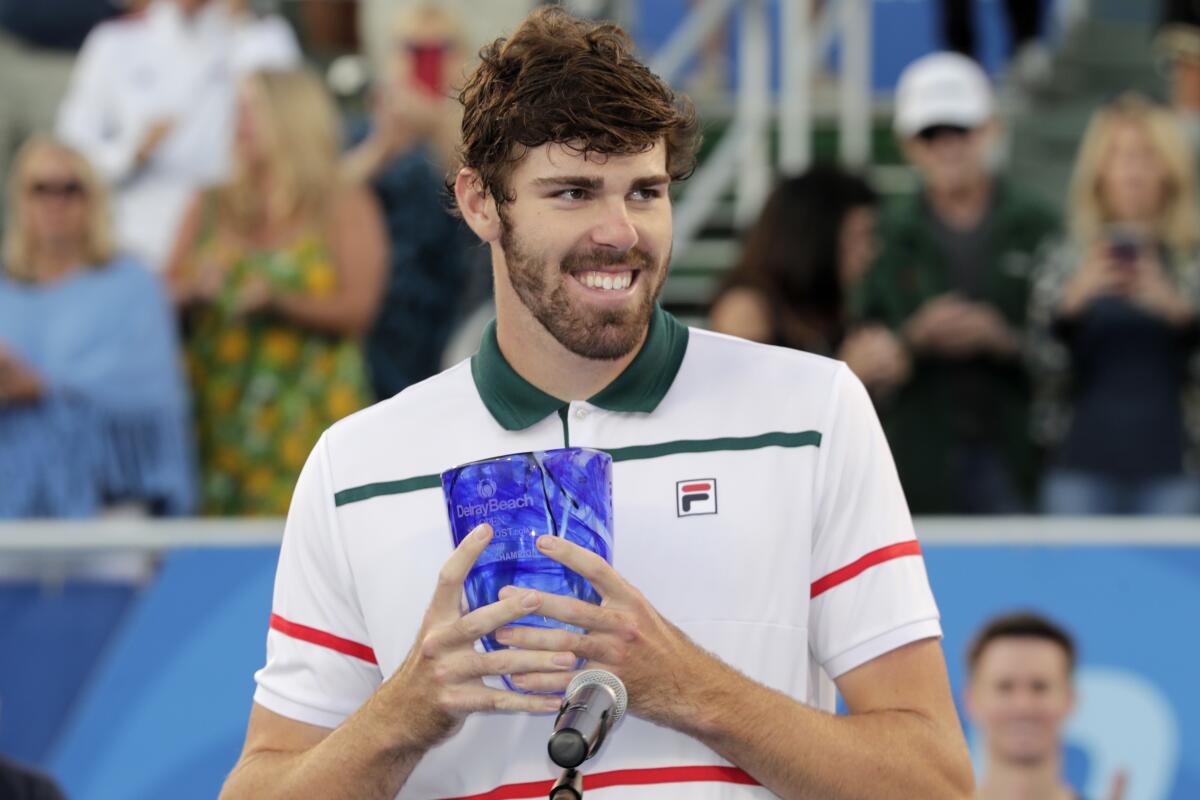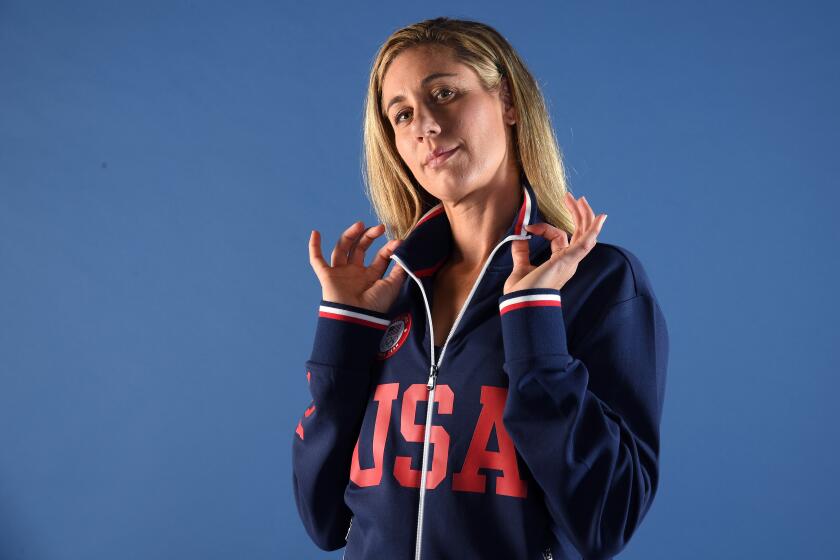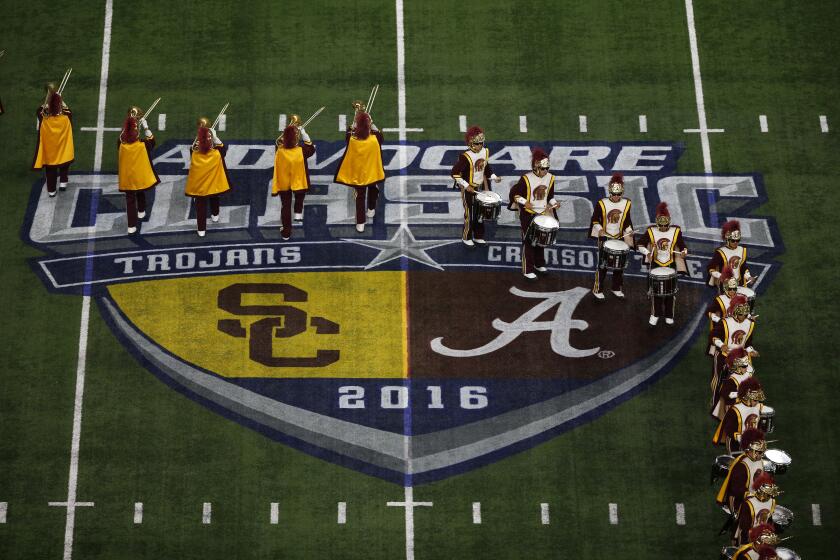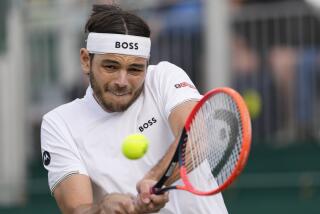Column: Backyard tennis, anyone? Sam Querrey, Marcos Giron headline Rolling Hills tournament
The lone spectator at the first professional tennis tournament played in the U.S. in two months had little to say about it, except an occasional “moo.”
Four male players participated in the first UTR Pro Match Series event last weekend at a private home in West Palm Beach, Fla., part of an effort to bring live tennis back from the coronavirus-induced shutdown. The players, who are based in Florida, went through health screenings and handled their own towels and drinks while playing a best-of-three “fast-four” format, in which winning four games wins a set. They played with marked balls and tapped racquets after each match instead of shaking hands.
There was a chair umpire, no linesmen, frequent court cleaning and no audience other than a cow grazing in the distance. The cow politely followed etiquette during play, though it had disrupted practices. “I never heard a cow moo that loud, that often,” winner Reilly Opelka told the Tennis Channel.
The event inspired former University of Washington tennis player Jake Douglas to stage a tournament at his father’s Rolling Hills home this weekend. World No. 45 Sam Querrey and former UCLA standout Marcos Giron are among six planned entrants; only players’ families and friends will be allowed in and all will be socially distanced.
Tennis doesn’t look or sound like it did before sports came to a global halt in March. The steps it has taken toward a return are deliberately small and defiantly different in format, designed to give hungry fans a few bites of competition while following safety restrictions.
The empty seats are eerie, and it’s odd not to see ball kids or hear the usual music and noise. But for now it’s a welcome novelty and a chance for players to earn money, no small consideration. The ATP men’s tour Friday suspended events through July 31; the women’s WTA tour has suspended events through July 12.
Beach volleyball star April Ross discusses the challenges of waiting an extra year for a shot at her first Olympic gold amid the coronavirus outbreak.
“We treat it almost like an experiment with great benefit for all, so we can all see how it’s operating,” said Stacey Allaster, chief executive of professional tennis for the U.S. Tennis Assn. “I applaud all of the sports that are trying things. This is a new world for us. I thought what the NFL did with the draft was fantastic. I’ve never watched an NFL draft, but I applaud them for trying. Was it perfect? No, it wasn’t the NFL draft that they wanted, but it was something for their fans and sort of a trial, and to have that experience and learn from that was great.”
The first significant stirring occurred when Yannick Hanfmann, a two-time NCAA champion at USC, bested an all-German field to win the Tennis Point exhibition indoor event at a private club in Hohr-Grenzhausen, Germany, two weeks ago. In the UTR event last weekend, Opelka prevailed in a field that included four players in the top 60. UTR chief tennis officer Stephen Amritraj, who grew up in Encino, wouldn’t disclose the prize money but said players took it seriously. “You could definitely see that there were guys pushing themselves to the limit. It wasn’t your hit-and-giggle exhibition,” he said.

Similar intensity is expected in Douglas’ backyard this weekend, even though prize money will be limited to $10,000. The Tennis Channel will gather interviews but won’t air the event.
“We thought it would be a great idea to get a tournament going as hopefully, the pandemic has been calming down some and we believe we can put on a tournament that would be very entertaining,” Douglas said.
The UTR series will return to West Palm Beach next weekend for a tournament scheduled to feature Alison Riske (who is married to Amritraj), Amanda Anisimova, Danielle Collins and Ajla Tomljanovic. “Same place, same guy’s backyard. Same cow in the background,” said Bob Whyley, senior vice president production and executive producer of Tennis Channel.
A local 18-person crew worked on last week’s telecast, down from the usual 50. Remote and drone cameras were used, and commentators spoke from a Los Angeles studio. There were two robotic cameras at mid-court and two cameras on 24-foot long arms on opposite end zones. “It gives the viewer an amazing experience,” Whyley said. “Quite frankly, if I could do jib cameras and robotic cameras on all the matches that we do, even when there’s a little bit more normalcy, I would, because it looks great.”
Allaster liked the drone camera. “It might not work at the U.S. Open, but it’s the principle of being creative, utilizing technology and how we can innovate the sport through the opportunity to play within the social distancing rule,” she said. “Sometimes we’re creatures of habit. We like what we like. But then you get introduced to something new and different and you come along for the journey.
“We, as a fairly traditional sport, I think this is a really cool opportunity for us as a sport to push ourselves for the engagement of our fans virtually.”
The Power Five conferences vary in their approaches to playing during the coronavirus outbreak, but they know they need to work on a solution together.
UTR (Universal Tennis Rating) is a system that encompasses all age levels and skills; the company is a partner of the Tennis Channel. Amritraj saw UTR as a natural to lead tennis’ return. “Being progressive is a bit easier when you’re a startup that’s able to move quickly and be a little more agile than one of the seven governing bodies,” he said, referring to the WTA, ATP, International Tennis Federation and each of the four Grand Slam events.
“The pro match series was really a way to showcase how tennis could be done safely and how a one-on-one match can have implications into UTR, which is the most accurate global system in the world.”
He also said UTR is in discussion to back more tournaments, good news given the uncertainty about the return of big events. Allaster said the USTA remains focused on staging the U.S. Open as scheduled for Aug. 24-Sept. 13 and has devised several safety-driven plans. “We’re looking at mid-June to end of June to see which model is the one that’s feasible and, again, enjoying this period of time as we watch other sports bring live competition back,” Allaster said. “I think we at the USTA, we have that benefit right now to learn from the other sports.”
There’s much to be learned from innovation. Even the cow would approve of that.
More to Read
Go beyond the scoreboard
Get the latest on L.A.'s teams in the daily Sports Report newsletter.
You may occasionally receive promotional content from the Los Angeles Times.













